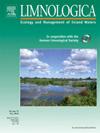Lability of sedimentary organic nitrogen estimated from amino acids in a reservoir on land reclaimed from Isahaya Bay, Kyushu, Japan
Abstract
In 1997, the inner part of Isahaya Bay on the west coast of the Ariake Sea was separated from the sea by dikes, leading to the formation of a freshwater reservoir. Since the Isahaya Reclamation Project began in the 1990s, red tides have become more common in the bay. Studies suggested that a non-negligible amount of NH4+ was regenerated from organic matter decomposition in the turbid water drained from the reservoir into the bay, and this drainage water might be an important source of NH4+ for red tides in the bay. Although labile organic matter in the turbid water might also originate from resuspended sediments in the reservoir induced by the drainage process, the potential for the resuspended sedimentary organic matter to serve as an NH4+ source has never been evaluated. In this study, we found that sediments near the drainage gates on the dike in the reservoir contained high levels of amino acids and NH4+. In addition, the NH4+ concentrations were positively correlated with amino acids concentrations. This result can be explained by increasing NH4+ production according to labile organic nitrogen accumulation in the sediments near the dike. The result of our study suggests that the sediment resuspension near the dike induced by drainage might be a source of bioavailable nitrogen for Isahaya Bay.

 求助内容:
求助内容: 应助结果提醒方式:
应助结果提醒方式:


